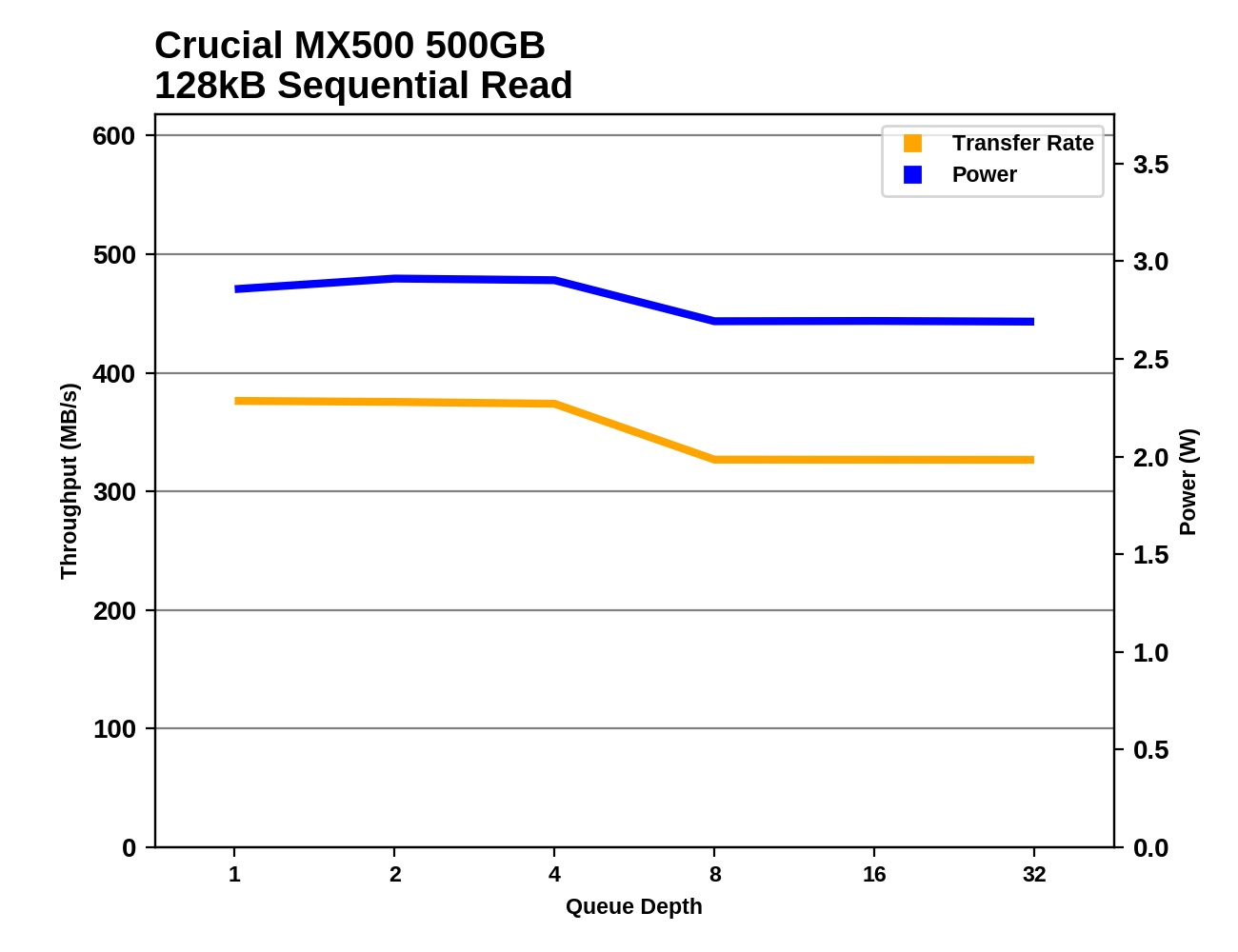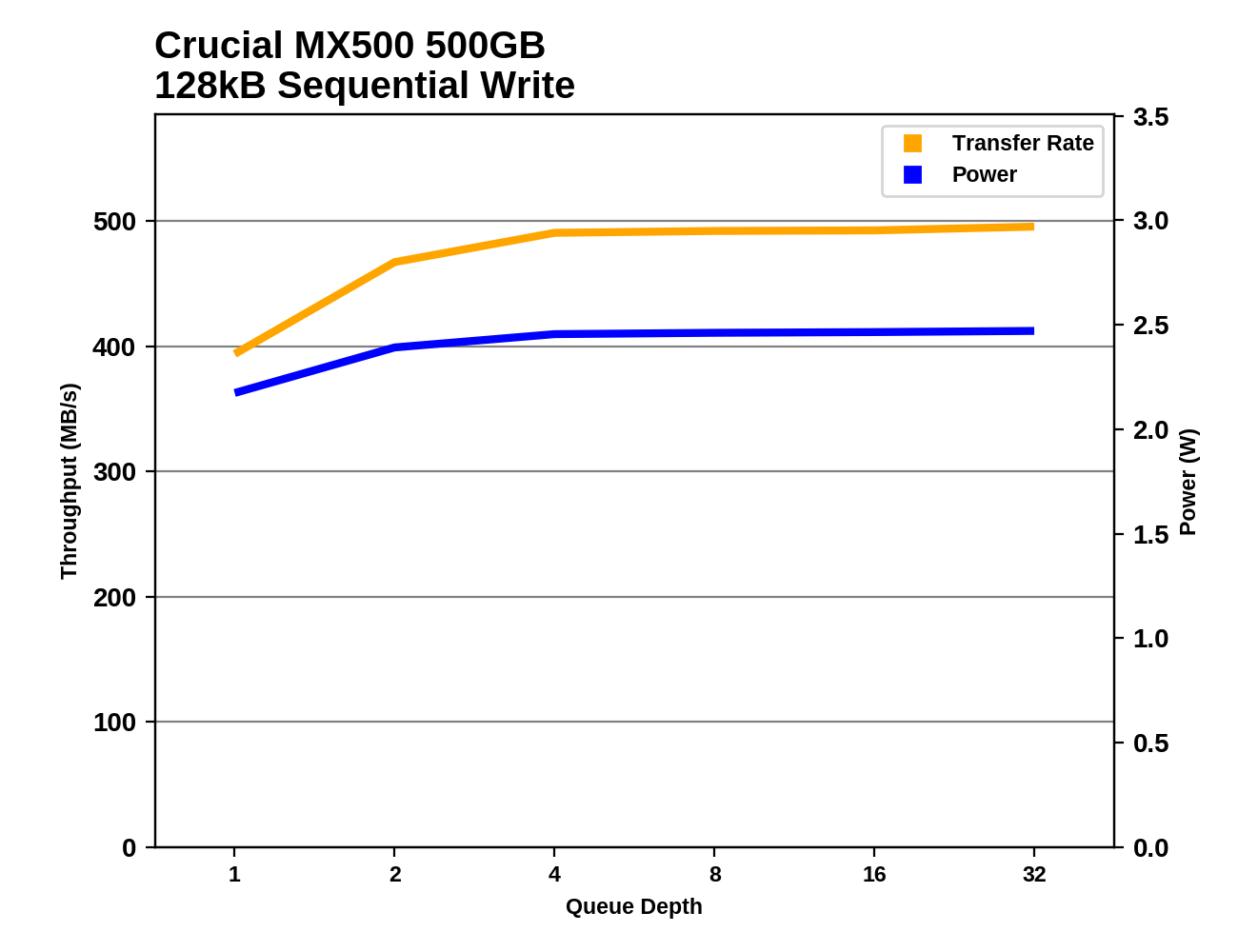The Crucial MX500 500GB SSD Review: A Second Look
by Billy Tallis on February 2, 2018 9:30 AM ESTSequential Read Performance
Our first test of sequential read performance uses short bursts of 128MB, issued as 128kB operations with no queuing. The test averages performance across eight bursts for a total of 1GB of data transferred from a drive containing 16GB of data. Between each burst the drive is given enough idle time to keep the overall duty cycle at 20%.

The Crucial MX500 is tied with the BX300 for fastest burst sequential read performance from SATA SSDs in this capacity range, even managing to beat the Samsung 860 PRO by a few MB/s.
Our test of sustained sequential reads uses queue depths from 1 to 32, with the performance and power scores computed as the average of QD1, QD2 and QD4. Each queue depth is tested for up to one minute or 32GB transferred, from a drive containing 64GB of data.

The sustained sequential read performance of the MX500 is much better than the MX300, but still not up to Samsung's level, and the 500GB MX500 is significantly slower than the 1TB model on this test.

Crucial's power efficiency on the sustained sequential read test is still poor, and the 500GB MX500 is worse off than the 1TB model. Meanwhile, Samsung has significantly raised the bar with the 860 PRO.
 |
|||||||||
Unlike the 1TB MX500, the 500GB MX500 hits its full sequential read performance at QD1, but neither can maintain it through the entire test. The 1TB and 500GB models use almost exactly the same amount of power, but the 1TB model is significantly faster.
Sequential Write Performance
Our test of sequential write burst performance is structured identically to the sequential read burst performance test save for the direction of the data transfer. Each burst writes 128MB as 128kB operations issued at QD1, for a total of 1GB of data written to a drive containing 16GB of data.

The burst sequential write performance of the Crucial MX500 is tied with the Samsung 850 EVO for being the fastest result from a TLC SSD. The 500GB MX500 scores slightly higher than the 1TB model, and is a big improvement over the MX300.
Our test of sustained sequential writes is structured identically to our sustained sequential read test, save for the direction of the data transfers. Queue depths range from 1 to 32 and each queue depth is tested for up to one minute or 32GB, followed by up to one minute of idle time for the drive to cool off and perform garbage collection. The test is confined to a 64GB span of the drive.

On the sustained sequential write test, the MX500 actually performs slightly worse than the MX300, but again the 500GB MX500 is a bit faster than the 1TB model. What was a tie between the MX300 and the 850 EVO last year is probably going to be a small but clear win this year for the 860 EVO over the MX500, but against other TLC drive the MX500 still looks great.

The two capacities of the Crucial MX500 show the same power efficiency during the sequential write test. They're less efficient than the MX300 was, but still near the top of the chart.
 |
|||||||||
By QD4 the 500GB Crucial MX500 is almost at its full sequential write speed, and its performance steadily gains the last few percent over the rest of the test. At lower queue depths, the MX500 is actually slightly slower than the MX300, but the MX300 couldn't retain its performance for the entire test.










25 Comments
View All Comments
jordanclock - Friday, February 2, 2018 - link
Generally, any good SATA SSD is going offer much the same performance as any other model. The gains when going from the second (or even fifth) best SSD on SATA to the absolute best are tiny. Plus, given the capacity you would want for a console, I think going for a 'mediocre' SSD will offer all the performance you need without spending twice as much for less than one second load time differences.leexgx - Tuesday, February 20, 2018 - link
this is true once you have a SSD (any) in a console your purely limited by the CPU speed and ram in the PS4 or xbox it self (some youtubers have tested it) even to the point the SSHD from seagate and toshiba after the second load is nearly the same as a SSD (but it has to have read the data before so if you load the same game or save twice for it work well witch mite happen if you die a lot and fall back to a checkpoint save) if you switch between games SSHDs can at times offer not as much benerfitstill can't beat SSDs for consistency as it always be the same speed
tamalero - Friday, February 2, 2018 - link
Those prices feel really nice!Hurr Durr - Sunday, February 4, 2018 - link
It's not nice until we hit around 10 cents for the gigabyte.zirk65 - Friday, February 2, 2018 - link
Looks similar to the MX200, but with bigger pipes and better thermals.MX200 = MLC NAND / Marvel Controller
MX500 = TLC NAND / Silicon Motion Controller
Yet I wonder much is different between the controller uArch these days, outside of specific I/O and power functions.
mode_13h - Friday, February 2, 2018 - link
Last I checked, Crucial's MX-series SSDs featured end-to-end data protection. Does Samsung offer anything like that, in their consumer drives?letmepicyou - Friday, February 2, 2018 - link
Say Mr. Tallis, I'm sure I'm not alone when I ask this (feel free to chime in, guys) but there are those of us out here who want the greater capacity of a 1tb drive whilst not wanting to fork over 1tb drive prices. I can RAID 0 a pair of ~500gb drives and get better performance than a single 1tb drive, while spending $60-$120 less.What I'm saying is, I would love to see how your arsenal of ~500 gb drives perform in RAID. I have a feeling others would like to see the same information.
Billy Tallis - Friday, February 2, 2018 - link
You can't get a pair of 500GB drives for $60 less than the price of a 1TB drive from the same product line, unless you're looking at an unusually good sale on the 500GB drives and not looking for the best price on a 1TB drive. Every 1TB SATA drive I price checked this week was cheaper per GB than its half-TB counterpart.As for RAID testing, my collection of drives almost never includes more than one of each. At the moment I'm finishing up a NVMe RAID review using a set of drives that was loaned by a vendor specifically for this review. Between the disappointing results I'm getting from that project and the prices I'm seeing that don't make SATA RAID economical either, it's not a priority for me to test SATA RAID.
Wardrop - Saturday, February 3, 2018 - link
Is that a software raid or hardware raid you used for your NVMe raid review. I'm guessing software as I'm not even sure any NVMe raid solutions exist. In that case, I imagine we're back to needing dedicated RAID controller to deal with the order of magnitude increase in drive performance compared to HDD's, and then obviously you're left questioning who needs double the increase in sequential performance when a single drive is usually more than fast enough for any sequential workload.peevee - Monday, February 5, 2018 - link
Check m.2 PCIe/NVMe 1TB and 2TB prices.But you'll need an MB with 2 M.2 slots with 4x PCIe connected to CPU, are those even available? Otherwise latencies will dominate the performance (like for M.2 which only provide SATA, either slots or drives).